
Software Review - iDVD 3 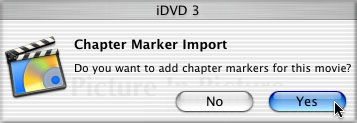
February 17, 2003
Review - iDVD 3

Software Review - iDVD 3 
February 17, 2003
Review - iDVD 3
Price $49.95: iLife available from Apple.
System Requirements
iDVD 3 requires a Power Mac G4 with an Apple SuperDrive,
running Mac OS X version 10.2 or later.
It also requires a minimum of 256MB of RAM installed,
with 384MB recommended.
I have been working in iDVD 2 for sometime now. I created DVDs for some of my customers, mostly artists. Using their original art work for all backgrounds and buttons, it was possible to give iDVD 2 a unique look. Always keeping run time under 60 minutes, the iDVD 2 MPEG 2 encoding did an excellent job. Burned about 60 DVDs (Apple brand media), never a misfire during burning and the DVDs played on DVD desktop units and computers with no problems. Robust and stable the only thing wanting are some new, more advanced features.
When iDVD 3 was announced I was ecstatic. With new features, including Chapter Markers, a good application was going to become much better. Alas, this is not the case. iDVD 3 shipped with several bugs that have hobbled this new version of iDVD. Some of the features that worked in iDVD 2 do not work in iDVD 3.
First I'll take a look at the new features in iDVD 3 and then I'll detail what is not working properly.
New Features
Chapter Markers
Probably the most anticipated new feature is Chapter Markers which iDVD 3 now recognizes and can utilize. Until now it was only possible to have Chapter Markers when working with DVD Studio Pro. Chapter Markers can be created in FCP, FCE and iMovie and be brought into iDVD 3, embedded in the movies. With Chapter Markers it is possible to move from scene to scene, via the remote control with desktop DVD players or by using the Chapter submenu that iDVD will automatically create for you when it detects chapters markers that have been set in FCP.
In FCP place your playhead at the position on the Timeline that you want to mark as the start of a scene. Now tap the 'm' key on the keyboard twice to set a marker and open the Edit Marker window. In the name section enter the name of the scene remembering that this is the name that will appear in the iDVD chapter submenu in your finished DVD. Next, click on the 'Add Chapter Marker' button, this will set the chapter marker and will enter "(CHAPTER)" into the comment box. Leave this exactly as it is as this comment is needed for the process of embedding the chapter markers, if you change this, Chapters will not work. Click okay and move your playhead to the next position and repeat the process. There is a limit of 36 Chapter Markers, if you use more iDVD will not accept your movie.
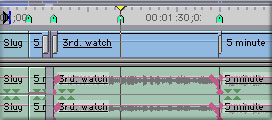
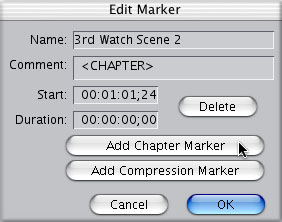
Once you have set all your markers, set an in and out point on your Timeline and from the File menu > Export > Final Cut Pro movie. In The Save dialog box set the 'Markers' drop down menu to "Chapter Markers", red arrow below. Then click Save. You are now ready to drop your FCP movie into iDVD.
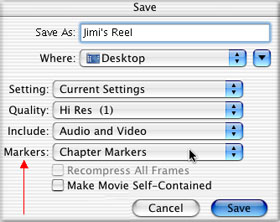
Before bringing your movie into iDVD go into iDVD Preferences. The first thing I always do is turn off the Apple logo watermark. Uncheck 'Delete rendered files after closing a project', below left. This will ensure that when you return to your project you will not be required to re render (read re encode) your project.
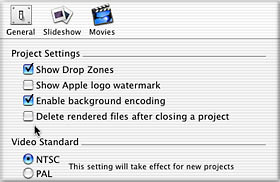
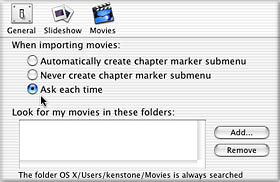
In the Movies section of Preferences, above right, "When Importing movies", I have selected 'Ask each time'. I do this so that when I import a FCP movie that has Chapters I will know that iDVD has detected the Chapters correctly. Each time you import a movie with Chapters you will be asked. If you decide that you do not want Chapter Markers in your iDVD simply select 'No' and the markers will not be imported with your movie.

If your iDVD page is empty when you place your movie in the iDVD interface, iDVD will add two items on the page. 'Play Movie' and 'Scene Selection', shown below left. Clicking on Scene Selection will take you to the first Scene Selection submenu, shown below right. In my example there are only 5 scenes, however, each submenu can hold up to 6 scenes. If your movie has more than 6 scenes (Chapter Markers) then iDVD will create additional Scene Selection submenus, with 6 scenes per page for a total of 36 scenes. When there are additional submenus, iDVD will place forward and back arrows for navigation.
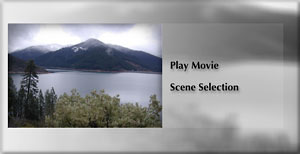
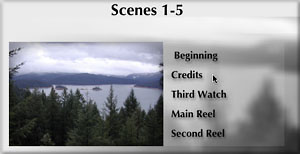
If you already have items on your iDVD page, Slide Shows, Folders or other movies then iDVD will place just the name of the movie, which when selected, will take you to a new page that will show 'Play Movie' and 'Scene Selection'.
Themes
iDVD 3 has added a number of new themes. These new themes are more sophisticated than themes found in earlier versions of iDVD (older themes are still available). Not only are these new themes more professional looking but several have motion menus which add to the over all look of the DVD. Shown below are some of the 24 new themes. Motion menu themes have a small circular icon denoting motion, red arrows below. Some of the themes have their own music which you can use, delete or replace with your own audio.
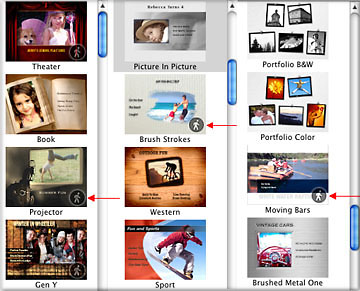
As with iDVD 2, you can drop movies or stills onto the theme. When working with movies they will play in a continuous 30 second loop although you can shorten the duration of the loop if you chose. With the Projector theme, shown below left, your movie plays on the screen in old fashioned sepia, complete with dust and scratches. As the project reel spins it is accompanied by the sound of a running projector. The Book theme, below right, is very handsome. The quality of the themes art is excellent, really very good. There are other exciting motion menus but, there is no way that I can grab screen shots of them to show you. It is exciting to have motion 'on' the menu and have a movie playing 'in' the menu as well.
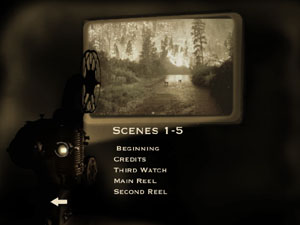
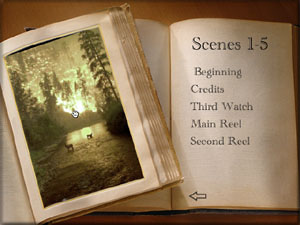
If you look at some of the sample themes shown above, you will see that any art used in a theme is placed into a type of frame. Be it a projector screen, a book page, or boxes. If you turn on 'Show Drop Zones' in the Preferences, as you drag your art onto the iDVD interface, the area for the art will have a black and yellow boarder showing you where to drop your art, below left - red arrows. A grabber tool, shown below right, is provide to reposition your art inside the borders. A great little feature but too limited in how far you can move your art.
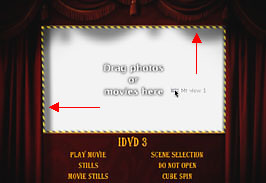
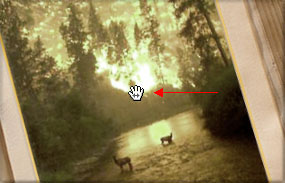
iHub and other enhancements
At the top of the Customize Window you will find Audio, Photos and Movies tabs. You can access any files that you have in iTunes, iPhoto or iMovie from inside the iDVD interface. Simply click on any item listed and drag into the iDVD interface.
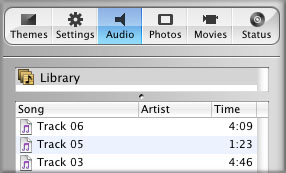
By checking the 'Always add original sideshow photos to DVD-ROM' box found in Preferences, below left, you will be able to include your source images as standard image files on your DVD. The Status tab of the Customize window, below right, now shows project information, both time and size of the project are displayed. A very helpful addition.

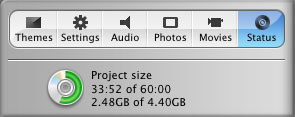
Along with your movies and slide shows you can also use your DVD as a DVD ROM. This is to say that you can place any data files on the same DVD as your movies. Word Documents, PowerPoint, PDF, any data files can be included. To add data files to your DVD first click on the Status tab and then select "DVD-ROM Contents from the drop down menu. Click on the new folder button at the bottom and name your folder, then drag any files you want into the folder.
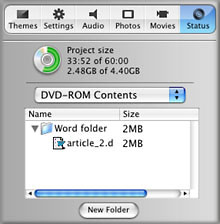
Custom Art and Poster Frames
Encoding Problems
What Happened in testing ?
If you want to use custom art for backgrounds, you will run into problems. Place a still on a page for a background, leave that menu page, come back and the still image could be gone. Make your own button art, leave the page, come back, gone. The same with Poster Frames. After setting a poster frame, upon returning to that page you may find that your Poster frame has reverted to the first frame of the clip. So the possibility of creating a custom DVD is problematic.
Once you have finished building your DVD you would think that you could click burn, load up a blank DVD, let iDVD encode and then burn, a process that can take several hours. This would be a mistake. One of two things will happen. Either it will spit out a unburned DVD midway through the process or it will hang during the burning process, spinning wheel of death. You will have to 'force quit' and you will have a ruined DVD.
For the best chance of getting a good burn you must wait until all the encoding has been completed, as shown below, then click on the burn button, insert your blank DVD and start the burn process. Even using this 'wait to burn' process, some are still unable to get a properly burnt DVDs. Even when you get a good burn, the progress bar which sits at 'about 2 minutes' for about 30 minutes will still say 'about 2 minutes' even after the burn is done and the DVD has been ejected. Go figure. There was some hope that the new Mac OS, 10.2.4 upgrade might solve this problem, but early reports show no change with the encode and burn problems.
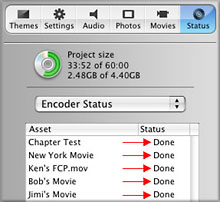
Chapter Markers
Chapter Markers do work as detailed above, but one element or option is missing. When you are in a Chapters submenu and click on one of the chapters, you are taken to that chapter and it plays. When the chapter is done playing it will then continue to play through all the remaining chapters on that submenu and then return you to the submenu. There should be a way to have iDVD return you to the submenu upon completion of the selected chapter. This should be an option.
Page and Chapter Links
Another problem with iDVD menus. In iDVD we have the ability to position our links where ever we want on the page, 'free position'. This works fine and displays properly on the Mac but once burnt to disk the links no longer display properly. As you scroll up and down the links, several different links will be lit up at the same time, but just parts of the links. Hard to tell which chapter you are on.
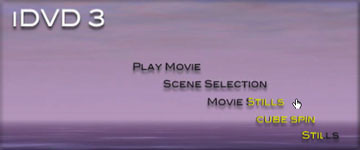
Loss of Audio Sync
It has been widely reported that movies created in iMovie 3 will lose audio sync after being burnt to DVD. There are several workarounds for this problem. Movies created in FCP have no audio sync problems when burnt to DVD.
Conclusion
iDVD is a powerful program, very well conceived. It enables us to author and burn DVDs right on our desktops. It is Mac 'drag and drop', yet versatile enough to allow us be creative in the design of our DVDs. I am a big fan. But there are issues. So what to do? Like many, I have reverted back to iDVD 2 to do my commercial DVDs for my customers, (iDVD 2 authoring article). If you have not yet ordered iLife for $49, wait. Apple had to know about these problems, so it begs the question: "Why did Apple ship this product"? Between not being able to customize the look of your DVDs and the problems with the actually encoding and burning process, I only wish that I could say:
Enjoy,
--ken
copyright © Ken Stone 2003